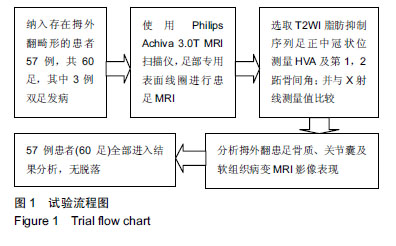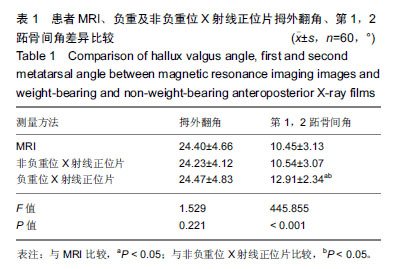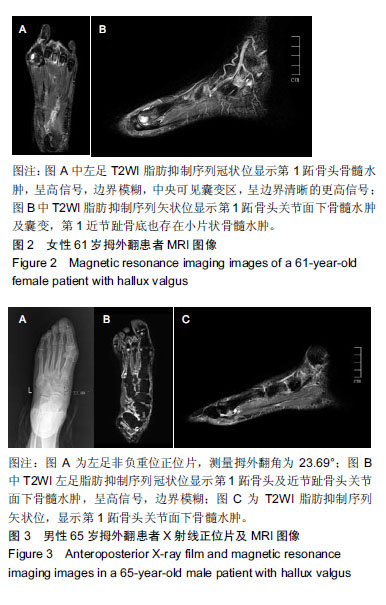中国组织工程研究 ›› 2019, Vol. 23 ›› Issue (24): 3857-3861.doi: 10.3969/j.issn.2095-4344.1296
• 骨与关节图像与影像 bone and joint imaging • 上一篇 下一篇
MRI评价拇外翻畸形:拇趾跖趾关节结构及位置的改变
郭 娟1,钱丽霞1,王晓东2
- 1山西大医院磁共振室,山西省太原市 030032;2太原市中心医院骨科,山西省太原市 030009
Magnetic resonance imaging in the assessment of hallux valgus deformity: changes in the structure and position of the metatarsophalangeal joints
Guo Juan1, Qian Lixia1, Wang Xiaodong2
- 1山西大医院磁共振室,山西省太原市 030032;2太原市中心医院骨科,山西省太原市 030009
摘要:
文章快速阅读:
.jpg)
.jpg)
文题释义:
拇外翻:是一种复杂的足部畸形,英文名称为“Hallux valgus”,由1871年Carl Heuter介绍。是指拇趾向外倾斜、第一跖骨向内侧倾斜,常伴拇囊炎和第一跖骨头内侧疼痛。
拇外翻角:指第1跖骨中轴线与近节趾骨中轴线之夹角,正常<15°。
第1,2跖骨间角:指第1,2跖骨中轴线之夹角,正常<9°。
摘要
背景:目前诊断拇外翻主要依靠临床查体及通过足部X射线正位片,评价第1跖骨与趾骨及第1,2跖骨的位置结构改变,而对于评价并发的骨质内部、跖趾关节囊及周围软组织病变存在局限性,MRI不仅可以显示结构改变,还可以显示其他并发改变。
目的:分析MRI在拇外翻畸形诊断中的应用价值。
方法:纳入行足部MRI检查的患者187例,通过X射线正位片测量拇外翻角及第1,2跖骨间角,诊断为拇外翻畸形的患者共57例60足,分析足趾位置结构改变和骨质、关节囊及软组织并发改变MRI表现。所有患者对检查方案均知情同意,且得到医院伦理委员会批准。
结果与结论:①拇外翻MRI与负重位、非负重位正位片拇外翻角测量值比较差异无显著性意义(P > 0.05);而MRI较负重位X射线正位片第1,2跖骨间角测量值小,差异有显著性意义(P < 0.05);②MRI不仅可以显示拇外翻畸形第1跖趾关节结构及位置的改变,其骨质、关节囊及邻近软组织也存在不同程度的病变;③40%(24/60)的患者存在第一跖骨或趾骨关节面下骨髓水肿及囊变,28%(17/60)的患者存在拇囊炎,30%(18/60)的患者存在第1跖趾关节腔积液,12足同时存在2种或3种骨及软组织并发改变;④提示MRI不仅可以显示拇外翻畸形拇趾跖趾关节结构及位置的改变,还可较好评价拇外翻骨质、关节腔、软组织病变及程度,能够更加全面的评价拇外翻严重程度。
中国组织工程研究杂志出版内容重点:人工关节;骨植入物;脊柱;骨折;内固定;数字化骨科;组织工程
ORCID: 0000-0003-4767-2042(郭娟)
中图分类号:
R459.9



.jpg)